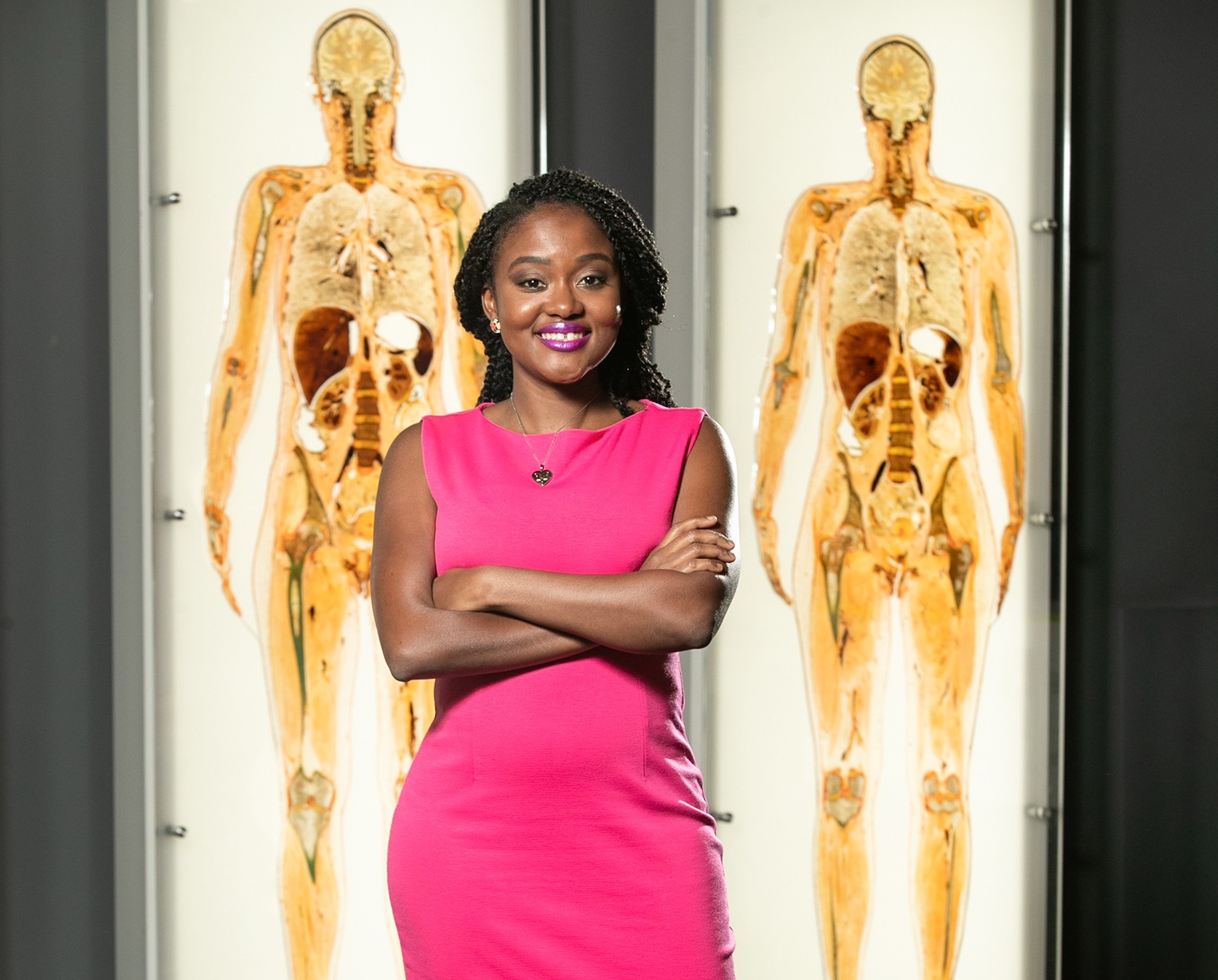
Cultivating curiosity
Arlyne Simon doesn't want to be a statistic. She is a biomedical engineer, patent-holding inventor, author, and entrepreneur. Today, that puts her among a very small number of women—especially women of color—but Simon is on a mission to change that.
22 min read
Each month, our Journeys of Innovation series tells the stories of inventors or entrepreneurs who have made a positive difference in the world. Hear it in their own words or read the transcript below.
Arlyne Simon: I really think inventing is magical. I mean, you identify a problem, you brainstorm, and then you come up with a technology that doesn't exist before. I mean, that is really magic. And I think if we position inventing in, in this sort of way for kids, then they're going to grow up with these critical thinking skills. And it's going to be so embedded in who they are that when they're grown up, they're definitely going to become patented inventors. Or they could be patented inventors as kids, too.
Joyce Ward: Transforming ideas into reality—it may sound like magic, but it's a power we all have within us. I'm Joyce Ward from the United States Patent and Trademark Office. I recently spoke with Arlyne Simon about the influencers in her life and how she is using her own influence to change the narrative about who becomes an inventor in America. In addition to her successful career as a biomedical engineer, Arlyne is also the author of a children's book series featuring a young inventor named Abby. Here is a bit of our conversation.
I think many people believe that inventors work alone, but it's really all about collaboration and the exchange of ideas.
Joyce Ward: Can you tell me a little bit about your research and your invention?
Arlyne Simon: Most of my research was done during my time as a graduate student at the University of Michigan. And the invention is really a quintessential story of the right people in the right place at the right time. Essentially, at that time in my life, I was very much interested in polymer science and its applications in biomedical engineering. And in our lab, we were exploring the use of aqueous two-phase systems, which are two polymers that dissolve independently in water.
After we filed this first invention disclosure, there was someone at the Innovation Center in the University of Michigan who was aware of our work. And she was also aware of a clinician in the Cancer Center who was doing some work with cancer protein biomarkers that are essentially elevated when cancer patients are rejecting a bone marrow transplant. She set up a meeting where she invited myself, my Ph.D. advisor, a mechanical engineering professor, his students, and that clinical researcher. And she said, “You know, you all have two, well, three, essentially, really good technologies. I just have a feeling that if I bring you guys in a room, then you guys can brainstorm how to collaborate and bring your technologies closer to the clinic, or from bench to bedside, essentially.” And that was really what started the work to essentially invent this blood test that detects when cancer patients are rejecting a bone marrow transplant.
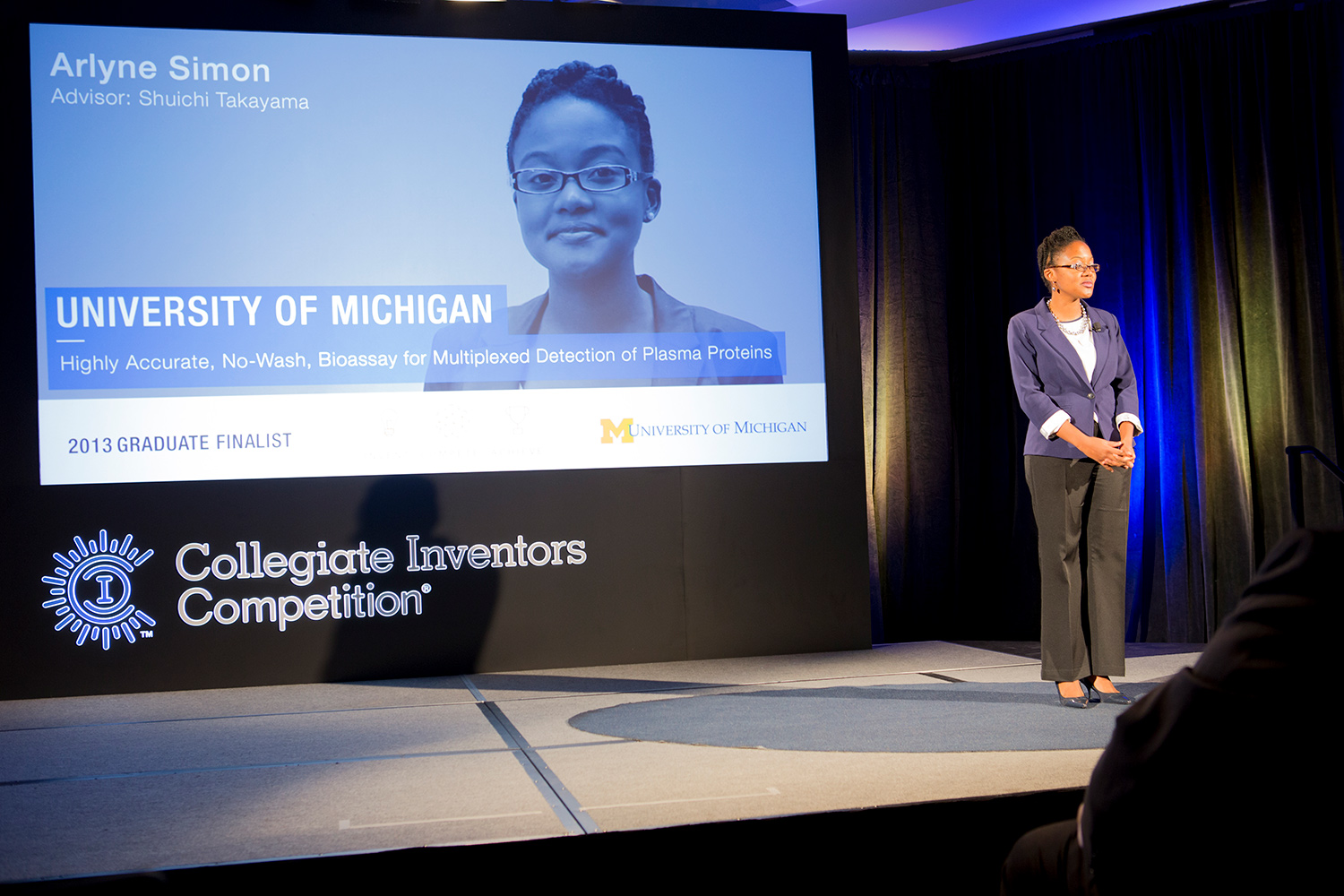
Arlyne Simon made her Collegiate Inventors Competition (CIC) pitch at the USPTO in November of 2013. She was one of seven graduate student finalists at this prestigious event sponsored by the National Inventors Hall of Fame and the USPTO. Photo by Amando Carigo/USPTO.
Joyce Ward: You were a Collegiate Inventors Competition, or CIC, finalist. What can you tell me about that experience?
Arlyne Simon: Being a finalist in the CIC competition was definitely one of my top five most memorable events, I believe, in my academic professional career. I didn't know that this competition was such a big deal until I flew to the USPTO headquarters. And in retrospect, I wish I had brought my parents or some relatives to cheer me along at that event. I was the only female out of the top seven graduate finalists that year. And I just remember being in a dream state, really, because I was just meeting all these National [Inventors] Hall of Fame inductees. They were, you know, shaking my hand, wanting to know who I was. The very first night that we were there we had a surprise where they unveiled billboards, and everybody had their face on a billboard.
And I, I think I cried a little bit, you know, like not, not like heavy cry, just a few tears because I'd never seen my face on a billboard, and it said “Arlyne Simon, Inventor,” and I don't know, that just seemed kind of surreal. And the next day, you know, I got to pitch my invention to judges who were all in the National [Inventors] Hall of Fame. I'm usually not nervous when I give presentations because I did business plan competitions and other things before, but these were like inductees. And that night, I remember Dr. Alfred Cho shared so many stories about his time at the Bell Labs with us, and that was just really fascinating. I met Dr. Jim West, the inventor of the electret microphone. I met Steve Sasson, inventor of the digital camera, and I remember telling him, “I'm going to take a photo of us with my camera, which you invented.” So, so yeah, it was, it was a really good experience. So forever grateful for being part of that competition.
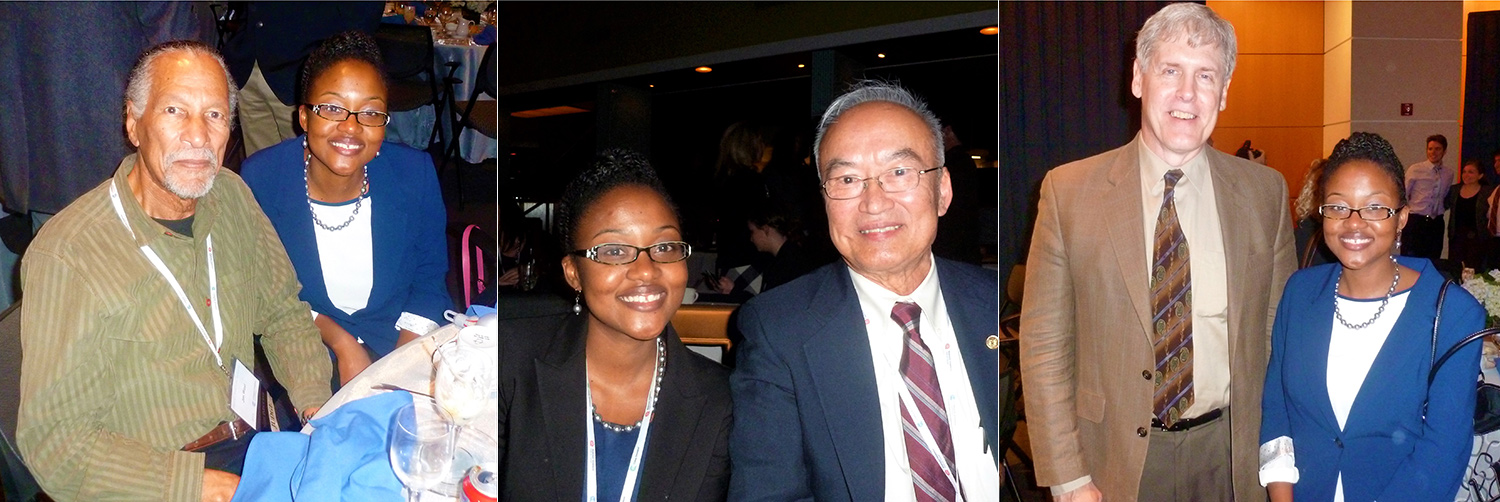
When she competed in the CIC in 2013, Arlyne Simon met several National Inventors Hall of Fame inductees who served as judges at the event. Left to right, Simon poses with Jim West, inventor of the foil electret microphone; Alfred Cho, a pioneer in the semiconductor industry; and Steve Sasson, inventor of the digital camera.
Joyce Ward: Can you tell me about PHASIQ?
Arlyne Simon: Yeah, and so PHASIQ was my first biotech startup, and I actually started PHASIQ before I defended my thesis at the University of Michigan. So that was a fun journey. My Ph.D. advisor and I decided that the work we were doing was worthy of commercializing, and so we formed a company, I think November of 2012, and I defended in May of 2013. We were successful in a sense that we got both the Phase I and Phase II Small Business Innovation [Research] grants from the National Science Foundation, but ultimately, the market was very competitive, and so after five years, we closed our doors, but the technology is definitely still up for licensing. So yeah, it was a good, good chapter.
Joyce Ward: What are you working on now?
Arlyne Simon: Right now, I work at a tech company designing medical imaging equipment like CAT scans, ultrasounds, MRIs, X-rays. So I work with a cross-functional team, and what we do is we help recommend the right CPUs, memory storage, and networking solutions to medical imaging manufacturers, and the result would be, you know, when you go to the doctor and you have to get scanned, then you can be assured that the radiologist is being presented with high-resolution images. That way they can pinpoint any diseases or any abnormalities in your scan.
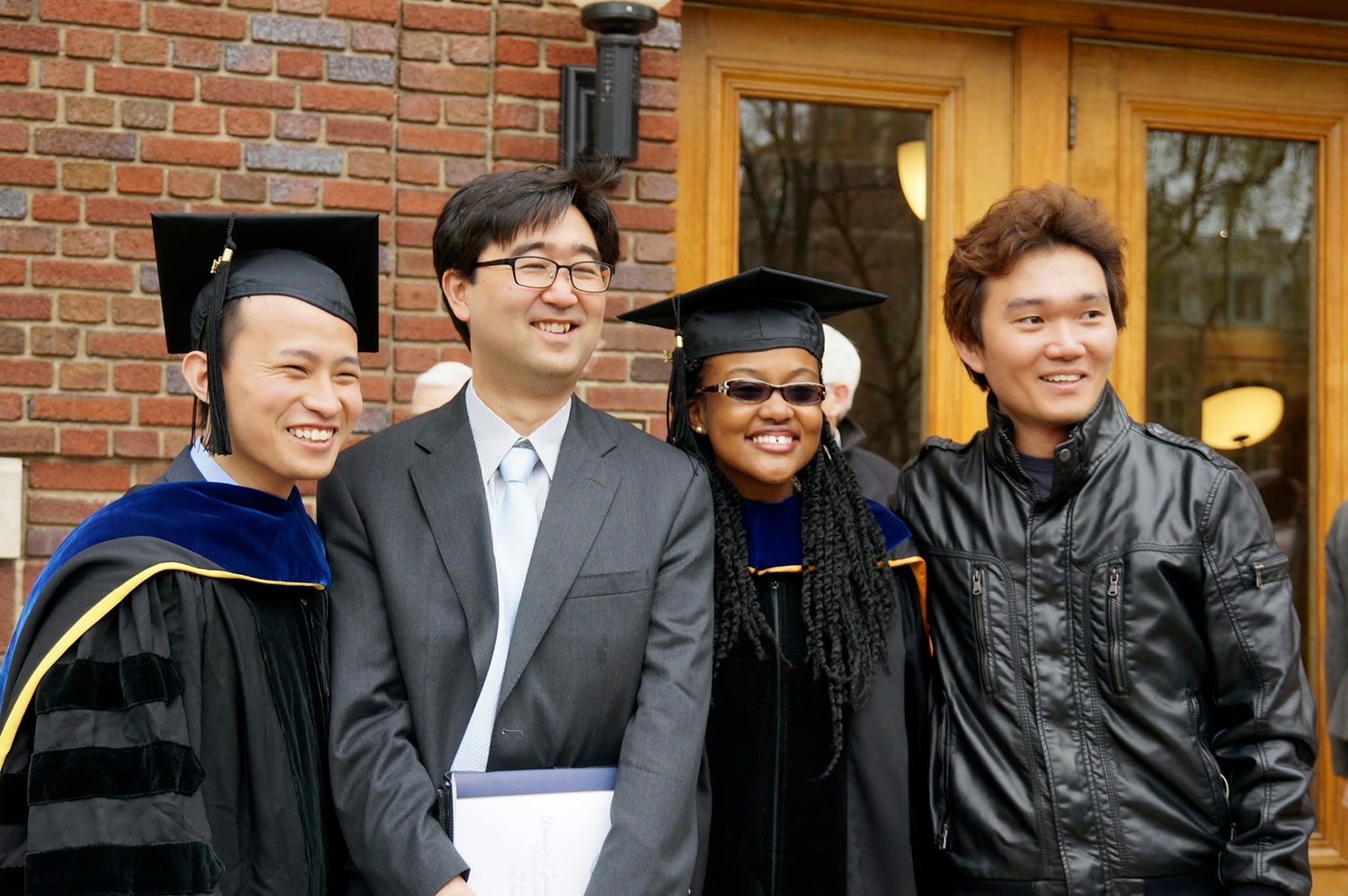
On her graduation day at the University of Michigan in May of 2014, Arlyne Simon poses with her faculty advisor and PHASIQ co-founder, Shuichi Takayama, as well as her lab mates David Lai (left) and Byoung Choul Kim (right).
Joyce Ward: Who helped you along the way, both with your initial invention and then building on it?
Arlyne Simon: Well, I worked in a very collaborative lab environment, so definitely my Ph.D. advisor. I had a lot of postdoc mentors who really helped me hone my skills in experimental design and just mapping out “What experiments did I test today?” and just kind of mapping out what my dissertation research would look like over the four- or five-year period. Of course, my peers, who were graduate students at the time, there were many times when we just met in one of our offices, just white-boarding and discussing some of the challenges that we saw in our experiments and asking each other for suggestions. I definitely worked with a very collaborative team, and even the clinical researchers at the Cancer Center gave me a different viewpoint as to immunoassay research. And some of the researchers there were M.D. Ph.D.s, and they would do their rounds in the morning, where they saw their patients, and then they would come to the lab. And so knowing that the work that we were doing had a direct clinical impact—in many ways, it was, you know, motivating, because the work that you do may potentially save someone's life. That was the type of environment that I did my research in.
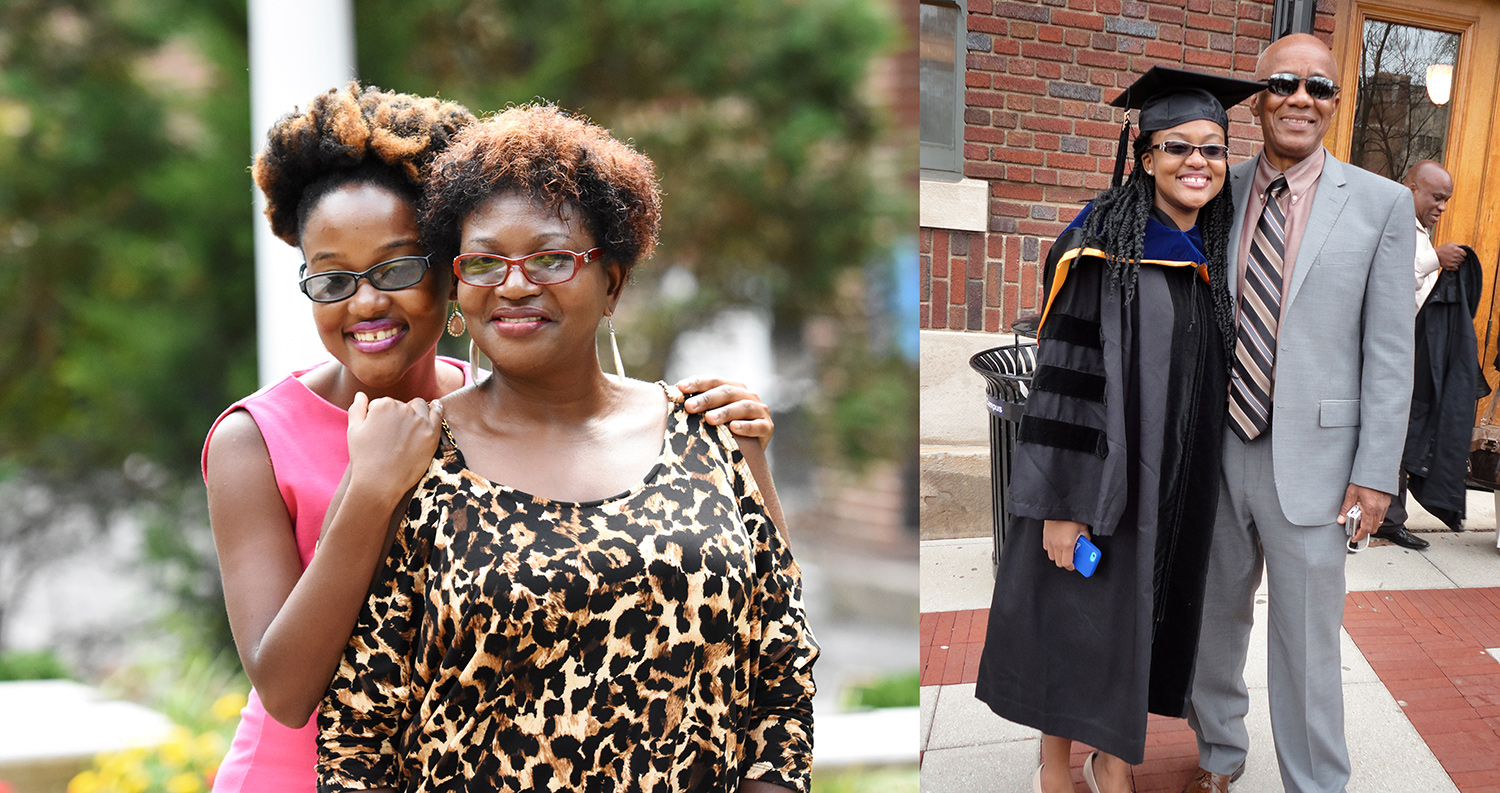
At left, Arlyne Simon poses with her mother, Beverly Stedman-Andrew. At right, Simon and her father, Lionel Simon, celebrate at Arlyne's graduation ceremony at the University of Michigan in 2014.
Joyce Ward: Whom did you admire the most growing up?
Arlyne Simon: There were many people I admired for different reasons. I kind of plucked away some of the skills that I liked from my parents. They were very hard workers. You know, my mom is a primary school teacher. My dad is a civil engineer. My stepmom is a secretary. Looking back at my life now, it's almost as if the career that I have—I am a biomedical engineer, just like my dad is a civil engineer; I write books, and my stepmom's a secretary and my mom's a teacher; I write books for kids. So somehow I crafted a career where I leverage the skill sets of the three people who helped raise me. So I think maybe they did make a very big impact on my life. In addition to my parents, one of my aunts was definitely somebody I admired because she was one woman who I knew personally who was a professional. She worked in the tourism industry, and after school, I would go to her office, and she had all these awards on her wall. And at the same time, she had such a good work-life balance. I would see her on the local news, talking about the work that she was doing to increase the number of tourist visitors to Dominica. You know, the next day, she would show up and take my brother and I to the beach or for ice cream. And I just thought that was amazing that she could be professional but still fun at the same time. And so I think I try to be that sort of person today.
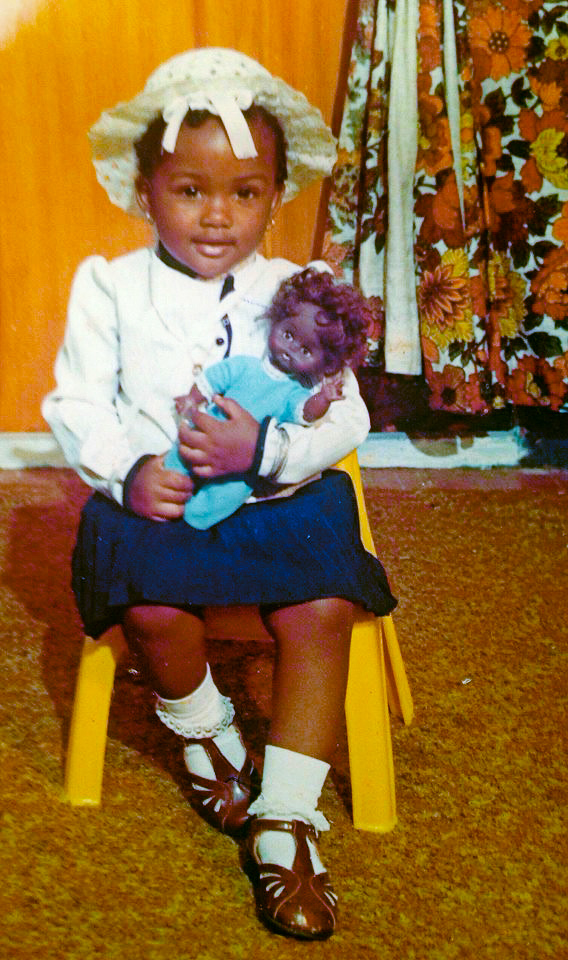
As a child, Arlyne Simon enjoyed playing school with her dolls. Her favorite doll accompanied her to church when she was about 2 years old.
Joyce Ward: Were there any teachers who influenced your journey?
Arlyne Simon: Absolutely. My favorite, favorite teacher of all time was Ms. Esther Robinson. She was my grade seven teacher. She made me love math and science because she taught it in song. She was also the choir instructor. And I still remember the song because she taught us this really catchy song on how to do long division. And I have a vivid memory of sitting, you know, in my end-of-year exam for grade seven, seeing the long division problems on the exam and singing the song in my head while I was getting the answers. She had a poem for the circulatory system. We had a song for how to spell words with “E” before “I,” or “I” before “E,” so she was definitely my favorite teacher of all time. In high school, I had a really, really good biology and math teacher. She would sometimes take us to the botanical gardens. We would sit on the lawn and just in nature. And she would just be talking about different plants and different animals. And I just remember that being really fun. So I think teachers definitely play a strong role in who you grow up to be.
Joyce Ward: What do you consider your origin story as an inventor? When did it all start? Where did it all start?
Arlyne Simon: I grew up in Dominica in the Caribbean. It's a very tiny island—the nature island of the Caribbean. So that's where it started. There was one day my mom came home from town with a book called “Simple Chemistry.” I was 5, and I remember her getting these jars in the kitchen, us being on the step outside, adding sand and water, stones and water, salt and water, hot pepper sauce and water, and her asking, you know, questions like, “Which one do you think is going to dissolve in the water?” And now I'm older, and even in graduate school, it's a little bit uncanny to me because my research ended up being polymers and their solubility in water. I don't think my mom intended me doing that, but it just seemed like a full circle moment when that ended up being my dissertation research project.
Since my dad was a civil engineer, sometimes I would go visit him at his office, and he would always be drawing what looked just like straight lines with angles. I mean, now I know that they were probably buildings or houses or something, but they just looked like straight lines with angles. There would be people, you know, dropping by his office, asking him questions, so it seemed important. Sometimes he would be driving and, you know, kind of point out to me the structures he was building or the road he was building. And so I think those sort of experiences helped, not necessarily telling me I was going to be an inventor, because “inventor” was definitely not something in my vocabulary until much later in life, but that's how I got involved in science.
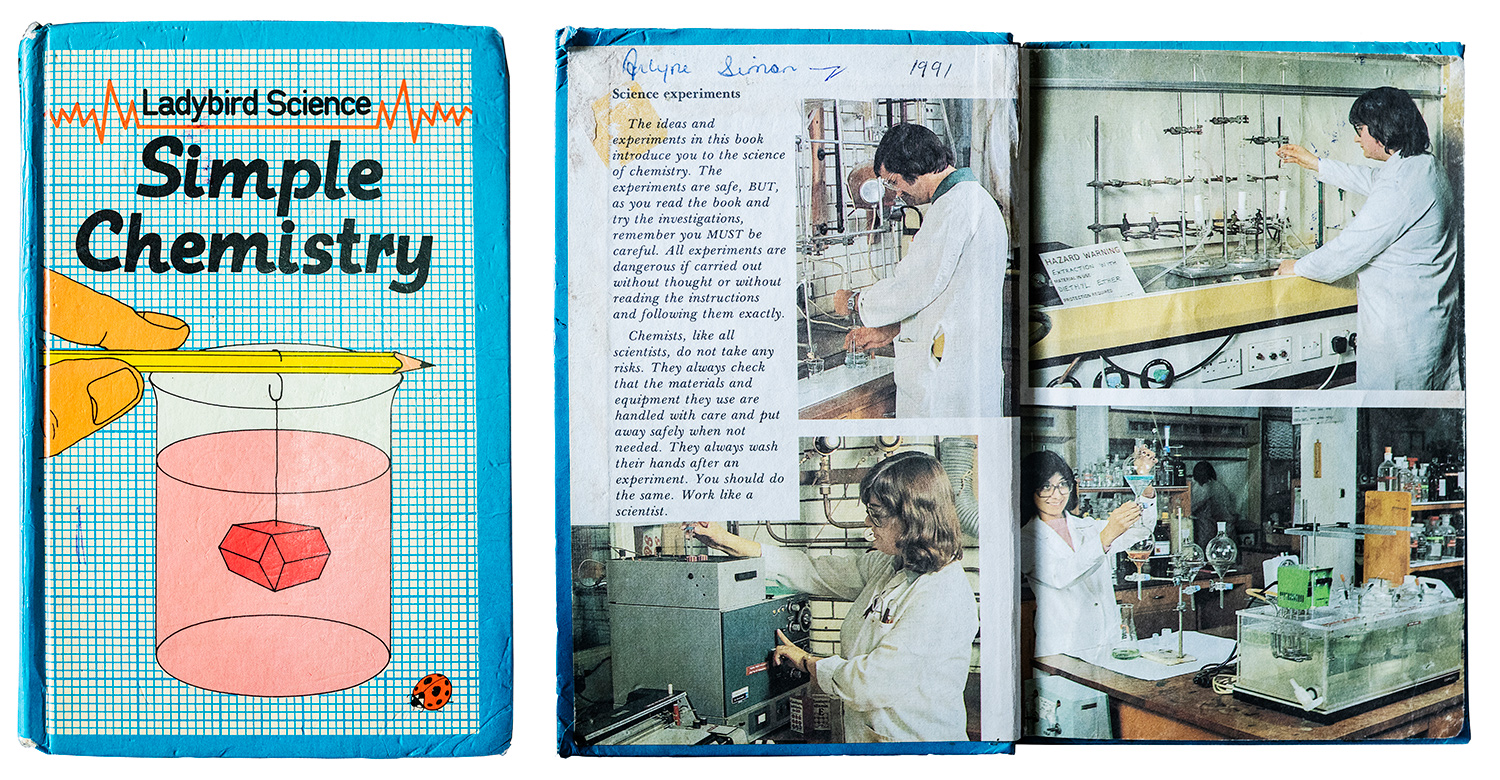
Arlyne Simon's passion for science was first ignited by her mother, who gave her John Paull and Dorothy Paull's book ”Simple Chemistry” from the ”Ladybird Science” series (Random House, 1982). The two conducted experiments from the book on the steps of Simon's childhood home in Dominica.
Joyce Ward: Over the course of your career, was there a specific time where you felt that you failed or wanted to quit, and how did you continue to move forward?
Arlyne Simon: Yeah, there were several times I definitely wanted to quit, particularly in my third and fourth year of graduate school. I think, you know, battling with imposter syndrome played a role because in my third year of graduate school, I didn't have any publications yet. And there's this notion in academia: publish or perish. And when you see other colleagues getting papers, even if at that time I had already filed an invention disclosure, it didn't seem equivalent to getting publications. I think I didn't really understand then the importance or the value of patenting, and in academia, it's very much publications, and I didn't have one yet, and other people did. So I definitely felt like a failure sometimes.
What I think helped me go on was my mom and my aunts always telling me, “You know, I remember last year or the year before you said you were going to quit because you were failing an exam, and then you got an “A” or a “B,” so I'm pretty sure this is just another time where you're just complaining for no reason.” Or my dad, you know, sort of reminding me to be patient and take breaks. And I had a really good friend who would send me affirmations or YouTube videos with motivational speakers. Or if I didn't want to go to lab and some people didn't see me in the lab for a couple days, they would show up at my apartment with cheesecake, because that's my favorite. I think having a good support system is really what helped me get through graduate school.
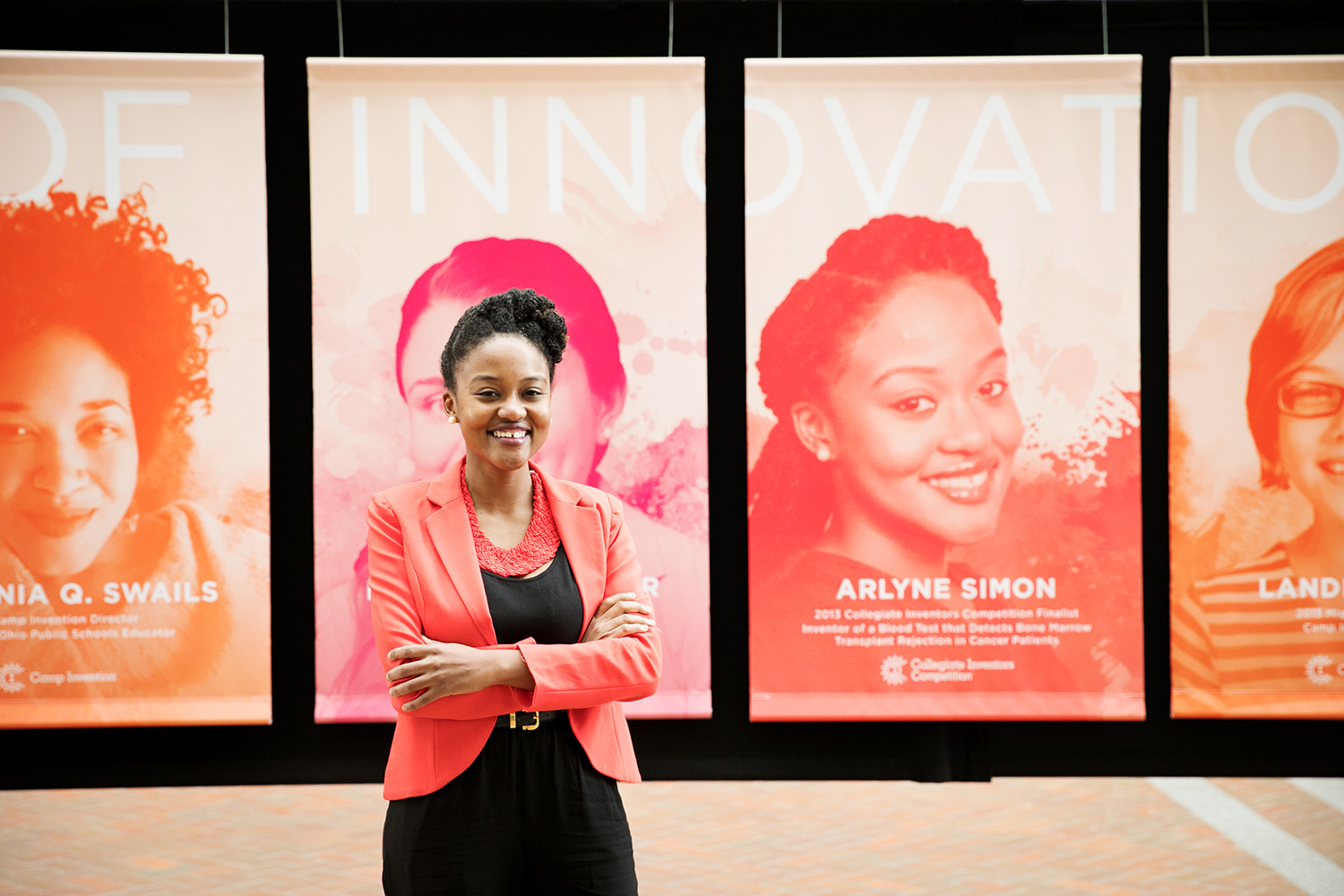
Arlyne Simon first appeared on a prominent exhibition display at CIC, but that wouldn't be the last time. She returned to the USPTO headquarters in March of 2017, when the National Inventors Hall of Fame featured her in its Women's History Month display highlighting the accomplishments of several female innovators who are inspiring other women and girls in science, technology, engineering, and math (STEM). Photo by Jay Premack/USPTO.
Joyce Ward: When was the first time that you heard the word “patent” or knew of someone obtaining a patent?
Arlyne Simon: I definitely heard the words “inventing” and “patenting” earlier in my life. I don't think I really associated those terms with something that I would have or a space that I would participate in. It really wasn't until graduate school, when my advisor, Dr. Takayama, said, “Hey, I think we should file an invention disclosure on this.” And even then, I was confused as to, “Why would we patent this? I thought in graduate school, we care about papers. Why are we patenting before we publish?” So those are some of those questions I remember having very early. My professor was really the first inventor that I knew because he has several patents, and so he was the first person who told me that I could be an inventor. So major thanks to him.
Joyce Ward: What role have patents and intellectual property played in your career?
Arlyne Simon: Well, I think patents definitely showcase that I am an inventor as well as an innovator. When we had PHASIQ, the biotech startup, whenever I pitched at business plan competitions, one of the first questions the judges or investors would ask would be, “Do you have IP on this?” For them, it was very important that if you're trying to commercialize something, that nobody could infringe on your work or sell your work for profits without your permission. I think that really set us apart early on in the startup process. That was definitely something that corporate partners, potential partnerships, viewed as, as important as well.
Joyce Ward: How many patents do you have, Arlyne?
Arlyne Simon: Today, I have two patents. There were three that were filed, but one got rejected. So I have two.
Joyce Ward: Do you have any trademarks?
Arlyne Simon: I am in the process of getting a trademark right now.
Joyce Ward: Do you have any copyrights?
Arlyne Simon: I do have copyrights because I write a children's book series called “Abby Invents.”
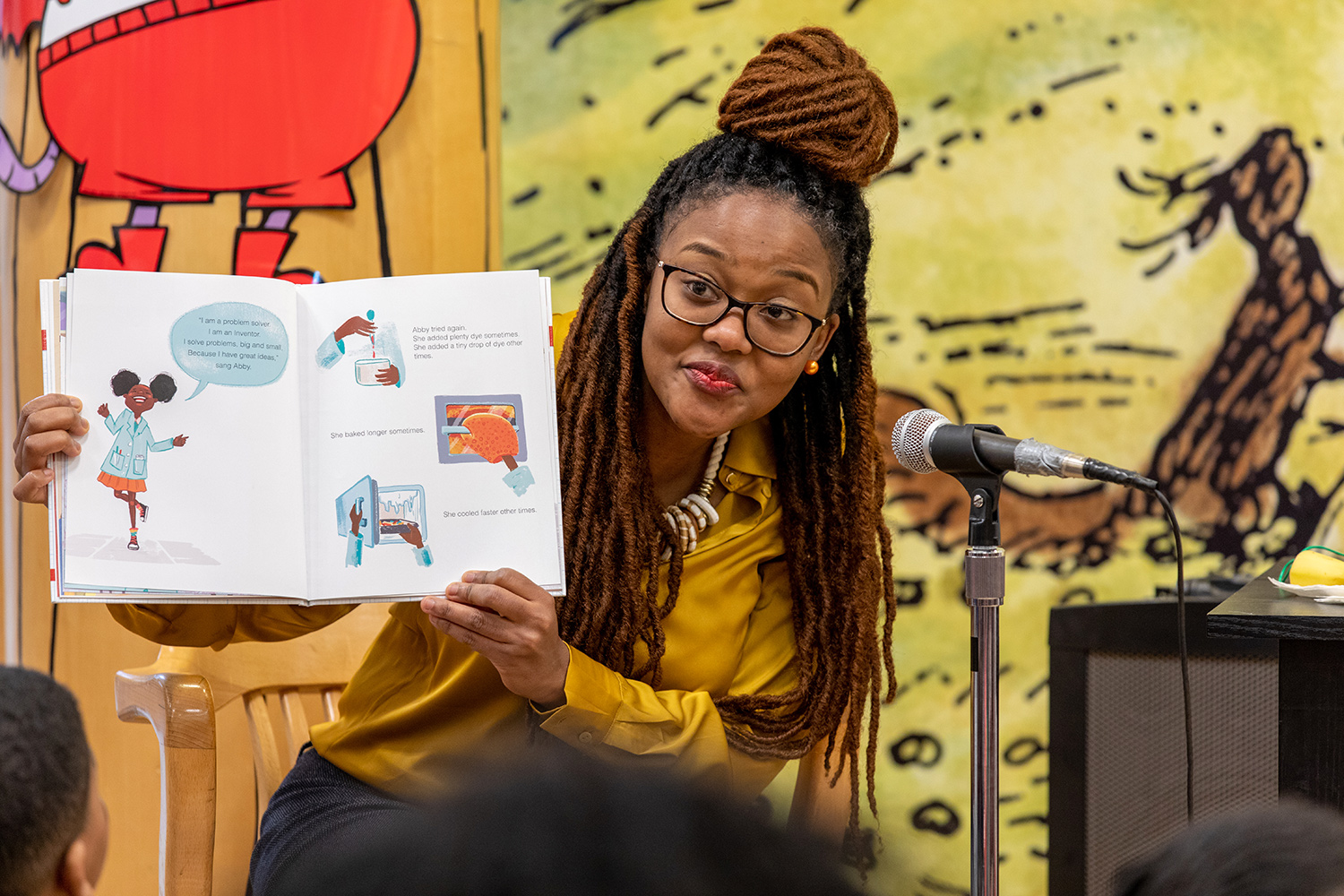
Arlyne Simon reads ”Abby Invents Unbreakable Crayons” to kids during a cultural literacy event and STEM fair at a Barnes & Noble bookstore in Portland, Oregon. Photo courtesy of Shawnte Sims.
Joyce Ward: So what inspired you to write a children's book?
Arlyne Simon: It was the day after my Ph.D. defense. And so I came to the lab for my final lab meeting, and my dad was there to visit for my defense. And when we were walking back to my car, you know, he asked, “Are you the only woman in the lab? Because I didn't see any other women there.” I was one of 17 people in the lab. And I remember laughing, telling my dad, “I'm pretty sure I told you that already, that in the last two years, I was the only female.” And I think that conversation with my dad sort of just stuck with me for a little while. And so I would ask myself often, “What can I do to increase the number of girls who have a desire to pursue STEM?” I loved reading, I loved STEM outreach, and so that's when I decided to write about a girl inventor called Abby. And that's how “Abby Invents” was born.
Joyce Ward: Is “Abby Invents” autobiographical?
Arlyne Simon: It's a little bit autobiographical. Writing to Abby was kind of writing to my younger self. And in the book, there's also an adult character inventor, Maya, who you can think of as adult me and Abby being little me. So the book opens where Abby meets inventor Maya, and she gasps because she says, “Oh my gosh, she looks, she looks just like me.” And for that moment, Abby realizes that she could be an inventor. So when her crayons are breaking and when she's just trying to color, you know, Abby gets frustrated, and she just wants crayons that never ever break. She asked her teacher to get her some, and her teacher is like, “I'm sorry, but all crayons break.” But because Abby met an inventor, Abby knows that “If I find a problem, I can brainstorm ways to solve it.” And so Abby goes on a journey to invent unbreakable crayons, and she gets a patent at the end of the book.
It's my way of introducing kids to the invention process, making it magical, making it fun, making it relevant—because they're all familiar with crayons and the frustrations of their crayons breaking—and introducing them to the word “patent.” Because, whereas I only knew about this in my 20s, there's no reason for them to not know about this when they're 6 or 7 or 8.
Joyce Ward: The teacher in “Abby Invents” tells Abby, “You are a problem-solver. You are an inventor.” Did anyone tell you this when you were a little girl?
Arlyne Simon: Nope. I don't think so. What I do know is my parents say I asked a lot of questions, and that I would talk for hours, just asking questions upon questions. So I was definitely curious. I don't know if I was a problem-solver or an inventor, but as a kid, I loved crafts. So sewing and, you know, always playing teacher.
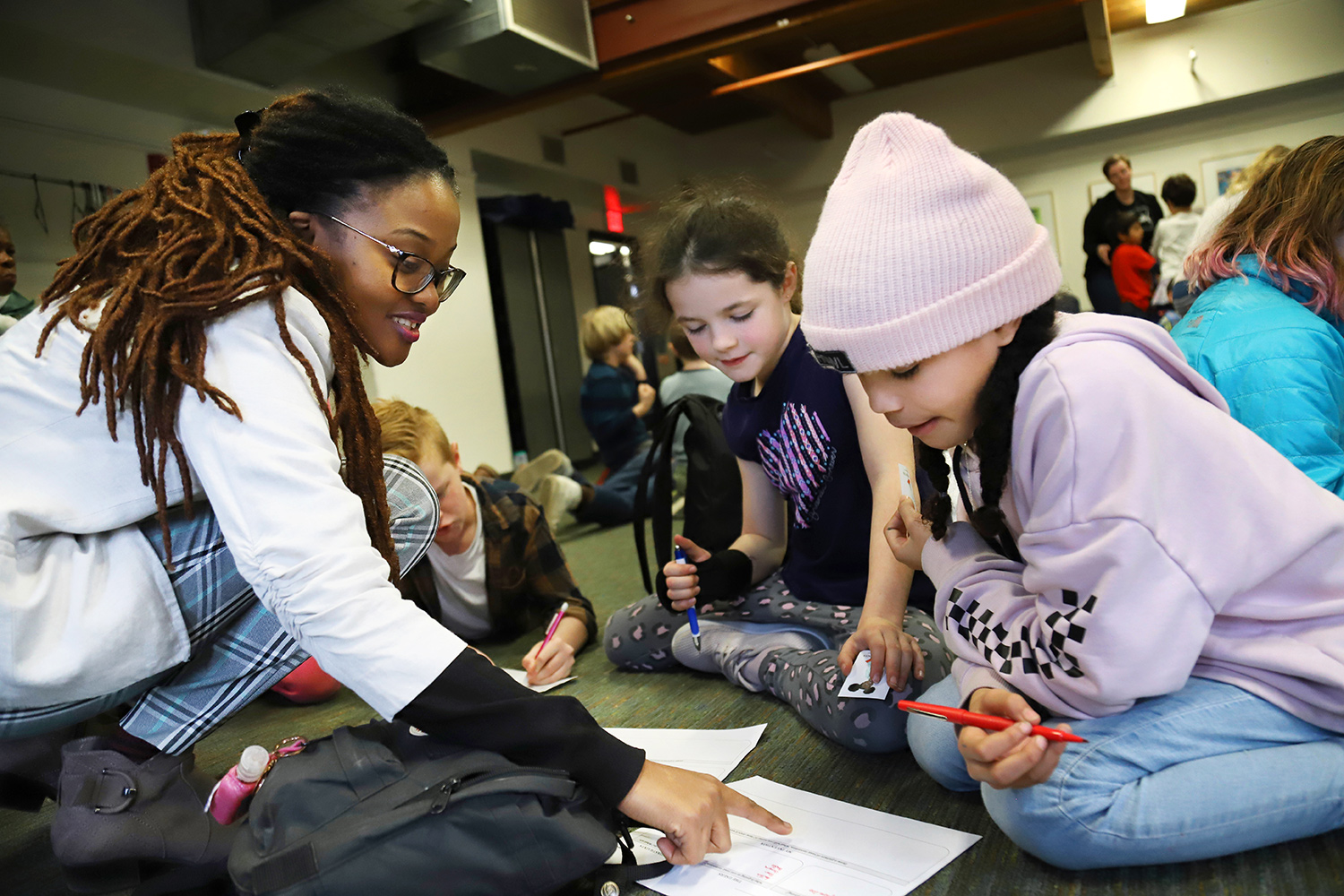
As part of her STEM outreach, Arlyne Simon led the students at Portland, Oregon's Friendly House through her ”Create Your Own Invention” brainstorming activity in February of 2020. Photo courtesy of Oregon Metro.
Joyce Ward: What role has mentoring played in your career?
Arlyne Simon: Mentoring has played, and continues to play, a significant part in my career. I think I've always had a mentor, but it's only in corporate America have I really truly labeled that this is a mentor. And so today, I would say I have a personal board of advisors, where essentially there are individuals who have a skill set that I admire, whether it be project management or strategic planning. In graduate school, it was postdocs who were just cranking out all these publications and me having the courage to say, “Okay, I would like to learn from you how you're doing this,” and then learning that there is a paper outline that's created even before you started doing the project, where you envision all of the figures that you want to see in the publication, and then you design your experiments in such a way to get those figures.
Joyce Ward: Do you mentor others?
Arlyne Simon: I do. There's an 8-year-old, a 15-year-old, and quite a few young professionals. We celebrate, whether it be for getting an “A” on an exam or the resume landed you a job or helping with salary negotiations. So basically teaching them everything that I know so that they don't have to make the same mistake at whatever stage they are in their life.
It just brings me so much joy, you know? I mean, it's amazing when you give suggestions to someone. Like one of my young professional mentees is getting her, her first job after her Ph.D., and she didn't know how to negotiate her salary, and I gave her like a blueprint. You know, if the employer says this, this is what you say, and you don't accept anything less than this. Even if you're afraid, just do it. And then she called me afterwards, and she was like, “Oh my gosh, you won't believe my salary.” And her salary is higher than mine when I started because nobody was there to kind of teach me how to do it. And so being able to do that for someone else just brings me a lot of joy.
Joyce Ward: What is the AAAS [American Association for the Advancement of Science] IF/THEN project?
Arlyne Simon: I am one of 125 AAAS IF/THEN Ambassadors, and our mission is really to encourage more girls, middle school girls in particular, to be interested in science. Our mission is, “If you support a girl in STEM, then she can change the world.” As part of this fellowship, there are quite a few projects that I'm involved in. One of them is collaborating with a nonprofit in San Diego called Science Delivered, and we are planning on creating a 25-person card deck featuring 25 different “STEMinists” who have really cool careers, like a bat scientist or a toy designer or someone in fashion or a ballerina who is also a rocket scientist. We can show girls that, you know, a scientist isn't usually just a boring person, that you can do many fun things with science. And then in a second project, me along with another IF/THEN Ambassador, Jasmine Sadler, we're launching an online program called FEMME Pals (Female Engineering Mentors and Me), where we want to connect Black middle school girls with mentors in engineering. That way, they would be more of like a pen pal relationship and getting postcards and care packages from someone professional.
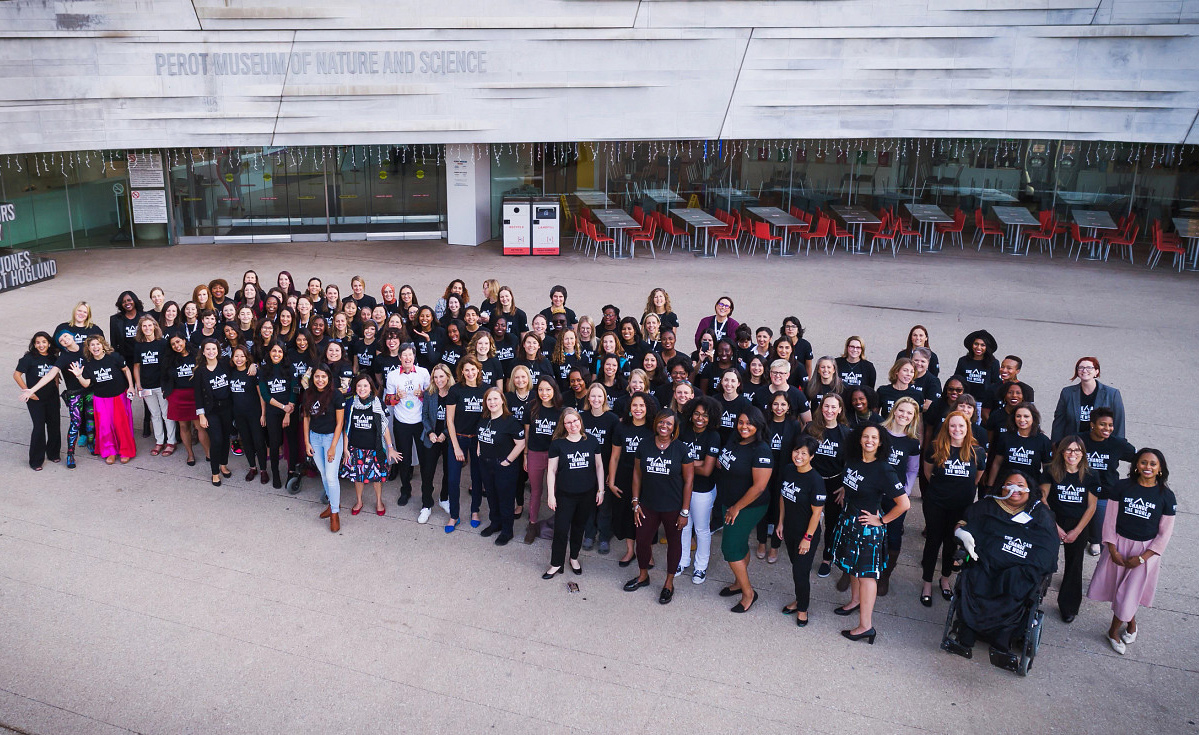
In partnership with the AAAS, Lyda Hill Philanthropies announced 125 AAAS IF/THEN Ambassadors in September of 2019. The program brings together diverse women from a variety of STEM fields to serve as contemporary role models for middle school girls. Above, Simon poses with her fellow AAAS IF/THEN Ambassadors at the Perot Museum of Nature and Science in Dallas, Texas. Photo courtesy of the IF/THEN Collection.
Joyce Ward: According to the studies, you are an anomaly as a woman of color with a Ph.D. and with patents. How do you do it, and how do we encourage and support more women and students of color—of any gender, students of any gender—to explore STEM, to become inventors, and to have awareness or to seek patents?
Arlyne Simon: Yeah, I don't like thinking of myself as an outlier. It is a statistic that I'm aware of, but it's, it feels, it's just a strange statistic. So I think how we get more girls to be in science is definitely the programs like I'm part of, like IF/THEN, just showing girls that there are 125 different ways that you can be a scientist, and I really think encouraging more girls to get patents starts from young, with like, with the book “Abby Invents,” you know, showing kids how magical inventing is. I really think inventing is magical. I mean, you identify a problem, you brainstorm, and then you come up with a technology that doesn't exist before. I mean, that is really magic. And I think if we position inventing in, in this sort of way for kids, then they're going to grow up with these critical thinking skills. And it's going to be so embedded in who they are that when they're grown up, they're definitely going to become patented inventors, or they could be patented inventors as kids, too.
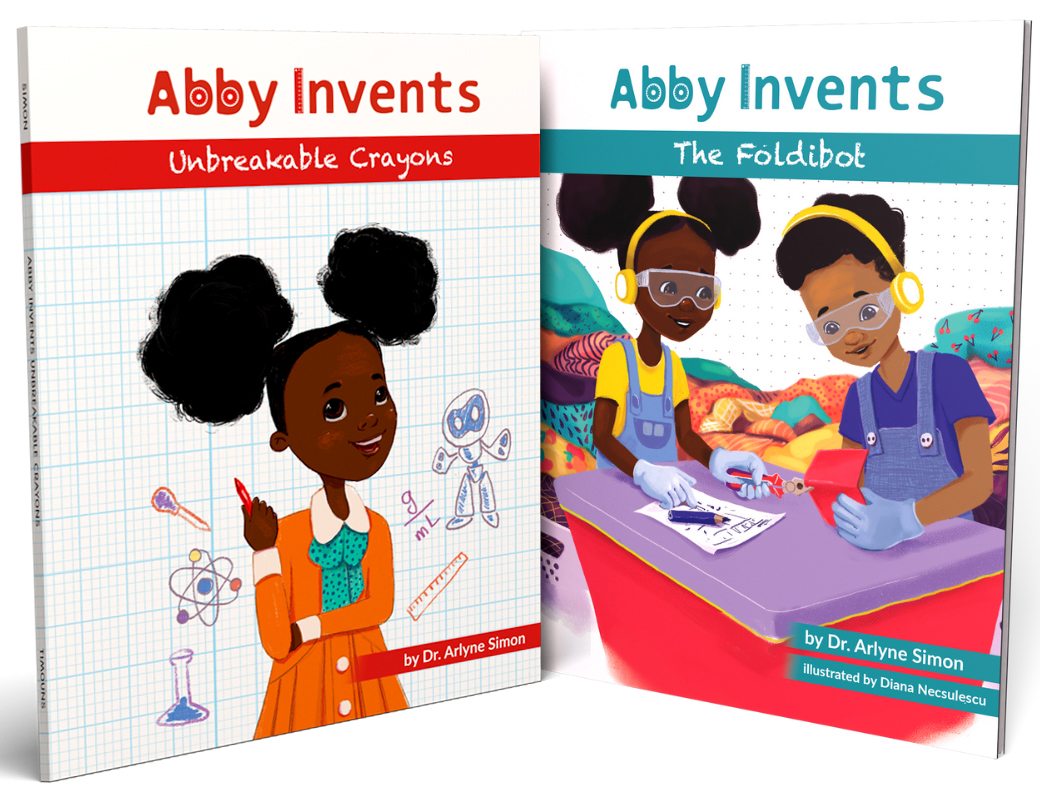
In her children's book series, “Abby Invents“ (Timouns), Arlyne Simon's protagonist “solves problems, big and small, because she has great ideas.” Simon highlights the themes of collaboration, failure, and perseverance as Abby pursues her invention journey and receives a patent in each book.
Joyce Ward: What type of environments do we need to create to help young inventors thrive?
Arlyne Simon: Definitely collaborative and inclusive environments. I am very certain if I did not have my advisor or my very diverse lab mates—and they were just so supportive of me—I don't think I would be an inventor today because I think many people believe that inventors work alone, but it's really all about collaboration and the exchange of ideas. And so without that support, I think it would be very difficult for a person of color or a woman to become an inventor.
Joyce Ward: Looking back at your career and experiences, what are you most proud of?
Arlyne Simon: There's so many things that I am proud of. It's hard to pinpoint one. I'm the first person in my family to get a Ph.D. On my mom's side, I'm the first person to go to college. Writing “Abby Invents,” even when publishers rejected it, having a patent. I don't know, it's hard, it's hard to pinpoint one thing to be proud of. I think all of these chapters helped shape who I am.
Joyce Ward: What advice do you have for students and young people who aspire to work in STEM or invent solutions to problems?
Arlyne Simon: The advice I would give to young people is, you know, don't, don't feel so bad if you get one or two bad grades. Just change your mindset and tell yourself that you're not where you'd like to be yet. And when you add the word “yet” at the end of the sentence, you're giving yourself room to grow. You're acknowledging that there are certain steps that you need to get to where you'd like to be. I think often we get so bogged down by our failures that the failures cause us to quit earlier. But you'll be surprised that the failure is really what helps you persevere and helps you stay for a long time in a career in STEM.
Joyce Ward: What inspires you?
Arlyne Simon: I am most excited about the next generation and the curiosity and creativity of kids. I've volunteered a bit with Camp Invention and other invention education programs, and it's always just the boldness of kids and their curiosity of the things that they want to invent. And I think sometimes, you know, as we go through life, we lose that boldness and that creativity. And so I definitely want to spend a lot of my focus trying to make sure that girls and boys and kids of color, just all kids really, keep true to that curiosity and that creativity.
Joyce Ward: We applaud Arlyne for staying true to her curiosity—and for paying it forward. She reminds us that making learning fun, relatable, and relevant is key to inspiring creativity in young people. Arlyne's journey also exemplifies the important role that family, teachers, mentors, and friends play in molding who we become, and it demonstrates the ways in which experiences build our confidence, shape our character, and encourage our boldness.
If you're a bold young innovator, or if you know someone who is, you can find resources for kids and teens on our website. You can also share your ideas for encouraging and supporting innovators by emailing us at education@uspto.gov. From the USPTO, thanks for listening.
Credits
Produced by the USPTO Office of the Chief Communications Officer. For feedback or questions, please contact inventorstories@uspto.gov.
Interview and story production by Joyce Ward. Audio editing by and contributions from Jay Premack. Additional contributions from Marie Ladino.
The image on the USPTO homepage and at the top of this page is courtesy of the IF/THEN Collection. Unless otherwise noted, all remaining images are courtesy of Arlyne Simon.
The transcript has been edited for brevity.
References
American Association for the Advancement of Science, IF/THEN initiative.
USPTO, National Council for Expanding American Innovation.
USPTO, ”Progress and Potential: 2020 update on U.S. women inventor-patentees,” July 2020.
USPTO, ”Report to Congress pursuant to P.L. 115-273, the SUCCESS Act,” October 2019.



